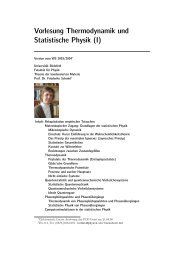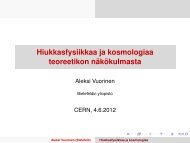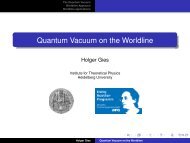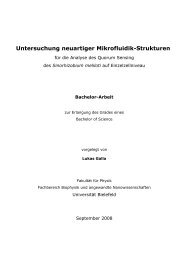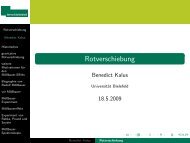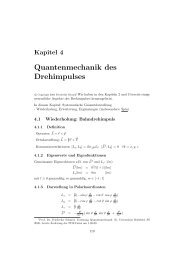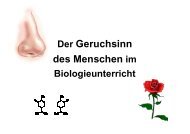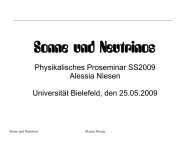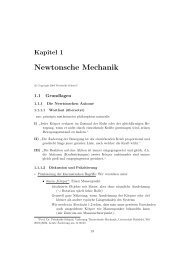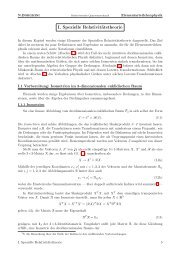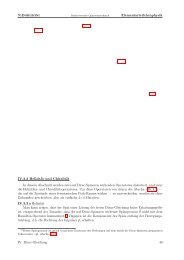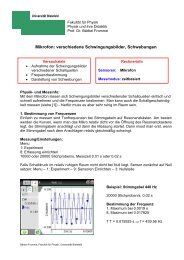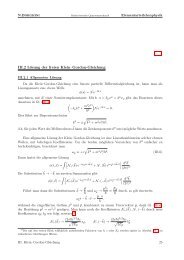De novo desmin-mutation N116S is associated with ... - ResearchGate
De novo desmin-mutation N116S is associated with ... - ResearchGate
De novo desmin-mutation N116S is associated with ... - ResearchGate
Create successful ePaper yourself
Turn your PDF publications into a flip-book with our unique Google optimized e-Paper software.
4598 Human Molecular Genetics, 2010, Vol. 19, No. 23<br />
Table 2. Overview on gene <strong>mutation</strong>s/variations<br />
Gene Variation a<br />
AA substitution a,b<br />
analys<strong>is</strong> of DES revealed the m<strong>is</strong>sense <strong>mutation</strong> p.<strong>N116S</strong><br />
(Fig. 1), whereas we did not find any variant among the<br />
desmosomal genes (JUP, DSG2, DSC2, PKP2, DSP). The<br />
patient h<strong>is</strong>tory revealed several ep<strong>is</strong>odes of syncopes, and<br />
task force criteria for ARVC were fulfilled [right ventricular<br />
enddiastolic diameter (RVEDD) ¼ 45 mm, left ventricular<br />
end-diastolic diameter ¼ 52 mm, biopsy <strong>with</strong> fibro-fatty<br />
replacement, electrocardiography <strong>with</strong> T-wave inversion in<br />
V4, V5 and V6]. The patient was transplanted at the age of<br />
17 due to terminal heart failure. The patient was<br />
re-transplanted at the age of 21, because the donor heart was<br />
actually rejected.<br />
Due to the identified DES <strong>mutation</strong>, the patient was also<br />
examined for skeletal muscle d<strong>is</strong>ease. At the age of 19, the<br />
patient started to complain of exerc<strong>is</strong>e-induced muscle pain,<br />
fatigability and weakness when walking uphill or climbing<br />
stairs. Neurological examination at the age of 20 revealed<br />
only a slight proximal weakness of the lower extremities and<br />
that her standing up from a squatting position was slowed.<br />
Cardiac and skeletal muscle pathology of the <strong>desmin</strong><strong>mutation</strong><br />
carrier. Immunoh<strong>is</strong>tochemical studies of myocardial<br />
sections revealed accumulation of <strong>desmin</strong> and myotilin<br />
immunoreactive aggresomes in the RV and left ventricle<br />
(LV) of the DES <strong>N116S</strong> heart after HTx. Of note, the aggresome<br />
formation appeared to be more prominent in the RV<br />
compared <strong>with</strong> the LV myocardium. In contrast in myocardial<br />
sections of a non-failing control heart, an even d<strong>is</strong>tribution of<br />
protein <strong>with</strong>out signs of the aggresome formation was<br />
observed (Fig. 2).<br />
Skeletal muscle biopsy from the quadriceps muscle was performed<br />
at the age of 19. Light microscopic studies were unremarkable<br />
<strong>with</strong> the exception of type 1 fiber predominance and<br />
some diffusely d<strong>is</strong>tributed rounded atrophic fibers. There were<br />
no inflammatory infiltrations, necroses, basophilic regenerating<br />
fibers, centrally located nuclei or structural changes of<br />
muscle fibers. Morphological studies revealed a diameter of<br />
Exon Patient ID References Mutation/GUS/polymorph<strong>is</strong>m<br />
DSG2 1174G.A V392I 9 1 (9,25) M<br />
DSG2 3G.A M1I 1 13 (25) M<br />
DSC2 1912_1917delAGAA hom<br />
Q638LfsX647 hom<br />
13 22 Novel M<br />
PKP2 235C.T R79X 2 5 (6,29,30) M<br />
PKP2 2176C.T Q726X 11 10 (6) M<br />
PKP2 658C.T Q220X 3 11 Novel M<br />
PKP2 1803delC D601EfsX655 8 21 Novel M<br />
DES 347A.G <strong>N116S</strong> 1 2 Novel M<br />
DSG2 1480G.A D494N 11 13 (21) GUS<br />
DSP 8531G.T G2844V 24 9 Novel GUS<br />
PKP2 2431C.A R811S 12 18 (28) GUS<br />
DSG2 2137G.A E713K 14 15 (7,22) P<br />
DSC2 2687_2688insGA A897Kfs901 17 14 (10,27,28) P<br />
DSC2 2393G.A R798Q 15 19, 7 novel P<br />
PKP2 76G.A D26N 1 03 (29) P<br />
DSP 5178C.A N1726K 23 16 (21) P<br />
a Nomenclature of sequence and amino acid changes according the specifications of the Human Genome Variation Society (HGV), all variants were heterozygous<br />
as not otherw<strong>is</strong>e mentioned; hom ¼ homozygous variant; b amino acid substitution; M, <strong>mutation</strong>; GUS, genetic variant of unknown significance; P, polymorph<strong>is</strong>m.<br />
Genes: DSG2, desmoglein 2; DSC2, desmocollin 2; PKP2, plakophilin 2; DSP, desmoplakin; DES, <strong>desmin</strong>.<br />
type 1 fibers between 11 and 76 mm (normal: 30–70 mm)<br />
and diameter of type 2 fibers between 14 and 67 mm, thus indicating<br />
an unspecific fiber atrophy (see Supplementary<br />
Material, Figure). Immunoh<strong>is</strong>tochemical stainings of skeletal<br />
muscle revealed some fibers <strong>with</strong> intracellular <strong>desmin</strong> and<br />
myotilin-positive aggresomes typically seen in patients <strong>with</strong><br />
myofibrillar myopathies (Fig. 3).<br />
N116 of <strong>desmin</strong> <strong>is</strong> located <strong>with</strong>in the 1A segment of the rod<br />
domain in the amino acid motif ‘LNDR’, which <strong>is</strong> absolutely<br />
conserved in the IF protein family (31, 32). Of note, there was<br />
no h<strong>is</strong>tory of ARVC or arrhythmias <strong>with</strong>in the family, which<br />
was supported by DNA sequencing of her parents and her<br />
s<strong>is</strong>ter. Thus, the DES-variant <strong>N116S</strong> in th<strong>is</strong> patient was<br />
found to be a spontaneous <strong>mutation</strong>.<br />
V<strong>is</strong>cosimetric measurements of <strong>desmin</strong> mutant protein.<br />
Specific v<strong>is</strong>cosity of the <strong>N116S</strong> <strong>mutation</strong> on <strong>desmin</strong> filament<br />
formation was investigated using, in Escherichia coli,<br />
expressed, purified full-length WT and mutant as well as<br />
various mixtures of <strong>desmin</strong> (75:25 and 50:50, respectively;<br />
Fig. 4). WT <strong>desmin</strong> exhibited an increase of specific v<strong>is</strong>cosity<br />
over a period of 40–45 min before reaching a plateau. In contrast,<br />
the specific v<strong>is</strong>cosity of <strong>N116S</strong> <strong>desmin</strong> transiently<br />
increased <strong>with</strong>in the first 10 min and declined almost to a preassembled<br />
value (0.02–0.04). These data reveal d<strong>is</strong>turbances<br />
of the filament formation of the mutant <strong>desmin</strong> in vitro. Intermediate<br />
kinetics were observed using mixtures of WT and<br />
<strong>N116S</strong> <strong>desmin</strong> (Fig. 4).<br />
Transfection studies in SW13 cells. To assess the ability of<br />
<strong>N116S</strong> <strong>desmin</strong> to assemble into a de <strong>novo</strong> filament network,<br />
WT and mutant <strong>desmin</strong> expression vectors were transiently<br />
transfected into IF-free SW13 human adrenocortical<br />
carcinoma cells (33). In contrast to the WT, <strong>N116S</strong> <strong>desmin</strong><br />
failed to develop an extended filamentous network as characterized<br />
by protein aggresomes throughout the cytoplasm<br />
(Fig. 5D and E). <strong>De</strong>smin staining was not detectable in<br />
Downloaded from<br />
hmg.oxfordjournals.org at Universitaetbibliothek 003 on February 11, 2011



